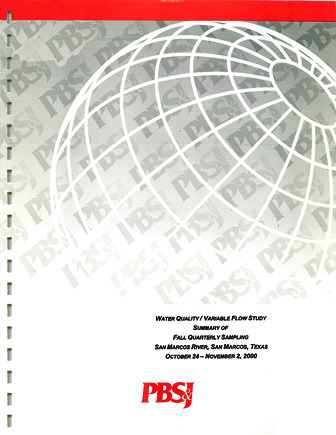Water Quality/Variable Flow Study Summary of Fall Quarterly Sampling San Marcos River, San Marcos, Texas October 24-November 2, 2000

| Summary |
|
This Annual Summary Report serves only to highlight the sampling activities that were conducted with respect to the Fall Quarterly Sampling (Comprehensive Monitoring Effort) on the San Marcos River. The report presents the sampling activities, brief summary of methodologies, sample locations, and raw data. The report also serves to satisfy the requirements of the Federal Fish and Wildlife Permit # TE820022-2 . The data reduction and analysis component of the project will be presented in the final report to be issued to the Edwards Aquifer Authority in February 2003. The PBS&J project team conducted the Fall Quarterly Sampling from 24 October to 2 November 2000 with the flows at San Marcos reporting 117 cfs on 27 October 2000, and 151 cfs on 2 November 2000. … Although the San Marcos River never reached the 100 cfs trigger level for critical period monitoring, it came very close. The 120 cfs trigger level was reached initiating specific Texas wild-rice observations. A critical period trip was initiated on 5 October when the flows had declined to 106 cfs. Dip netting activities were conducted on 5 October 2000. Several inches of rain fell over the weekend pushing the flows back up to approximately 114 cfs, thus cancelling the critical period trip. After that time, the flows at San Marcos stayed fairly stable until the completion of the Fall Quarterly Event. On the final day of sampling another round of heavy rainfall boosted the levels in the aquifer and thus increased the flows in the San Marcos system. However, the Fall Quarterly Event was conducted prior to this rainfall and represented fairly low-flow conditions. Water quality was measured for the system during this effort with all parameters measured being suitable for the biological communities. Aquatic vegetation was abundant and provided suitable habitat for biological communities. Within the two reaches sampled for fountain darters via the drop net methodology, suitable habitat for the darter was observed. Drop net sampling in both reaches produced fountain darters within the suitable aquatic vegetation types. In addition, dip net sampling was conducted in the Spring Lake Reach, City Park Reach, and I-35 Reach. Using dip nets, fountain darters were collected from all reaches. Suitable habitat for the San Marcos salamander was also noted in the four specific salamander sampling areas with salamanders observed in each area. During the September and October Texas wild-rice efforts, floating mats of vegetation were evident in certain reaches. These mats of vegetation were subsequently flushed out by the heavy rainfalls that occurred post-sampling. The gill parasite that has been reported for the fountain darter in the Comal system was not visually evident in fountain darters collected from the San Marcos River. As noted for the Comal system, the San Marcos Fall Quarterly Sampling provided a strong confirmation that the study design appears well suited to address the concerns of variable flow and water quality on the biological resources in the San Marcos system. It must continue to be emphasized that additional sampling in variable flow conditions to compare back to this fall quarterly sampling effort and future efforts remains critically important in order to best define and understand the system. |
Search for Documents
Advance Search
Explore EAA's Scientific Reports
- All Reports
- Groundwater Recharge, Recharge Zone
- Groundwater Movement
- Geomorphology and Caves
- Weather Modification
- Geology
- Water Use and Conservation
- Geochemistry
- Water Resources Planning and Management
- Floods and Drought
- Water Quality
- Climatology
- Surface Water / Groundwater Relationship
- Biology
- Springs, Groundwater Discharge
- Archaeology
- RZ Protection
- Aquifer Levels
- Remote Sensing
- Precipitation
- Overview Studies
- Modeling
- Hydrology and Hydrogeology
- History
